|
Mapping and development of alternatives to chlorinated lubricants in the metal industry (KLORPARAFRI) 8 Health and environmental screening of non-chlorinated lubricants
8.1 IntroductionA health and environmental screening of proposed non-chlorinated lubricant alternatives has been performed in phase 3 of the project. This was done with the aim to establish an overview of the health and environmental properties of the proposed non-chlorinated lubricants at a screening level in addition to identify and eventually sort out lubricants with obvious unwanted health and environmental properties prior to full scale production test. The original objective of this project was merely to focus on the extreme pressure additives (EP additives) of non-chlorinated alternatives, as the primary function of chlorinated paraffins in metal working lubricants is as EP additives. However, this quickly showed to be difficult. Substitution of chlorinated paraffins in lubricants for metal forming implies a complete reformulation of the lubricant. Most often it is impossible to precisely point out which of the components in non-chlorinated lubricants substitutes the chloroparaffins. Together, the individual components of the non-chlorinated lubricant form a complex chemistry resulting in lubrication during the metal forming process. Thus, it was rather quickly estimated in the project that the best basis for comparison between health and environmental effects of chlorinated and non-chlorinated lubricants was obtained through an evaluation of not only the entering components but also the entire lubricant. The health and environmental screening includes lubricants which possess promising lubricating properties in the focused metal processes based on supplier information and at the same time, where satisfactory compositional information has been obtained. In total a health and environmental screening has been performed for 14 non-chlorinated lubricants. The objective of chapter 8 is to describe the methods for the health and environmental screening of the proposed non-chlorinated lubricants and to provide and discuss the results of the screening. 8.2 Method for health screening of proposed non-chlorinated lubricantsAs in the health assessment of entering components in non-chlorinated lubricants, the health and environmental screening of alternative lubricants focuses entirely on the inherent properties of the components contained in the products. This means that the use of the product is not considered in the assessment. The screening of the proposed alternative lubricants is based on information retrieved at the suppliers (see also chapter 4) in addition to a search in Annex 1 to the EU Directive 67/548/EEC on dangerous substances and toxicological and eco-toxicological data in well-recognized handbooks and databases. The quality of the data is not rated. Thus, the screening of proposed non-chlorinated lubricants should be regarded only as an indication of the health and environmental properties. Based on the health and environmental classification of the individual substances entering into a lubricant in a concentration above 0,1 %, each substance is assigned a health and an environmental score respectively. The scores are assessed on the basis of a health and environmental rating system developed by CETOX (Centre for Integrated Environment and Toxicology). The system is developed as a tool to facilitate the differentiation between chemical substances and products with respect to health and environment. Both the health and the environmental rating systems comprise five hazard groups – health or environmental groups 1 to 5. Group 5 includes substances with the most severe health or environmental effects, while group 1 includes substances with no or few less severe health or environmental effects. The designation score corresponds to hazard group. The rating systems are described further in section 7.2 of this report. No or insufficient data (Score ND) Both the health rating and the environmental rating systems include an additional group comprising substances for which no data is available or for which the data available is insufficient to place the substance in a hazard group. For components in a lubricant placed in group ND there is either no or insufficient information available for a health or environmental assessment resulting in a classification and subsequently a rating. Score ND – health Assignment of a health score of a component demands as a minimum the availability of test data from animal studies on acute oral toxicity as well as data for skin and eye irritation and sensitizing potential by skin contact. Alternatively, a health score of a component can be established based on data from long term experience with human exposure by relevant routes. Score ND – environment Assignment of an environmental score demands as a minimum data for aquatic toxicity in addition to data on biodegradability. If there are no data on bio-accumulation, this effect can be evaluated on experimental or calculated data for water-octanol distibution. Health and environmental assessment of total lubricants Based on health and environmental classifications for the individual components in a lubricant, the product classification is calculated in accordance with the EU classification principles for preparations described in EU Directive 99/45/EC on classification, packaging and labelling of dangerous chemical preparations. A product health and environmental score respectively are assigned based on the product classification. Reference point A chlorinated lubricant (approximately 50 % Cl) used by Danfoss A/S in relevant metal forming processes at the time of this project is used as the reference point in the health and environmental screening of alternative lubricants. The lubricant contains 80 % of a medium-chained chlorinated paraffin. 8.3 Results of health and environmental screening of proposed lubricantsA health and environmental screening has been performed for 16 non-chlorinated lubricants. Below are stated the results of the health and environmental screening of the proposed non-chlorinated lubricants in addition to the results of a health and environmental screening of a reference lubricant - a chlorinated lubricant. The figures representing the individual products illustrate the percentage content of components placed in the individual health and environmental hazard groups. The designation score corresponds to hazard group. The product health score and the product environmental score is stated in the text below the figures. 8.3.1 Product no. 10
Fig 8.1: Relative content of components in product no. 10 assigned the individual environmental and health scores As can be seen from fig. 8.1, 5.0 % of the components in product no. 10 is assigned environmental score 1, 85.0 % is assigned score environmental 2, 5.0 % is assigned environmental score 3 and 5 % is assigned environmental score 4. All components in product no. 10 are assigned health score 1. The total product is assigned environmental score 3 and health score 1. 8.3.2 Product no. 12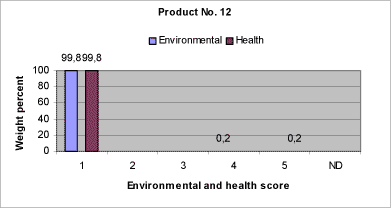
Fig.8.2: Relative content of components in product no. 12 assigned the individual environmental and health scores. As can be seen from fig. 8.2, 99.8 % of the components in product no. 12 are assigned environmental and health score 1, respectively. 0.2 % of the components are assigned environmental score 4 and health score 5. The total product is assigned environmental score 1 and health score 1. 8.3.3 Product no. 15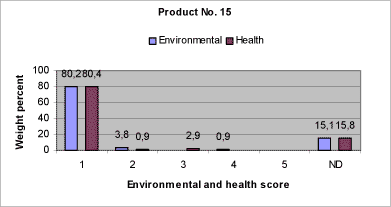
Fig 8.3: Relative content of components in product no. 15 assigned the individual environmental and health scores. The individual environmental and health scores for product no. 15 are illustrated in fig. 8.3. As regards environmental hazard, 80.2 % of the components in product no.15 is assigned score 1, 3.8 % is assigned score 2, and 0.9 % is assigned score 4. Regarding health hazard, 80.4 % of the components in product no.15 is assigned score 1, 0.9 % is assigned score 2, and 2.9 % is assigned score 3. For 15.1 % and 15.8 % respectively of the components in product no. 15 it is not possible to assign an environmental and health score due to insufficient data. Based on available data, the total product is assigned environmental score 1 and health score 1. 8.3.4 Product no. 18
Fig. 8.4: Relative content of components in product no. 18 assigned the individual environmental and health scores. The individual environmental and health scores for product no. 18 are illustrated in fig. 8.4. As regards environmental hazard, 25.2 % of the components in product no. 18 is assigned score 1, 0.7 % is assigned score 2, 0.8 % is assigned score 3 and 3 % is assigned score 5. Regarding health hazard, 26.8 % of the components in product no.18 is assigned score 1, 0.9 % is assigned score 3 and 0.7 % is assigned score 4. For 70.3 % and 71.6 % respectively of the components in product no. 18, it is not possible to assign an environmental and health score due to insufficient data. Based on available data, the product is assigned environmental score 4 and health score 1. 8.3.5 Product no. 24
Fig 8.5: Relative content of components in product no. 24 assigned the individual environmental and health scores. The individual environmental and health scores for product no. 24 are illustrated in fig. 8.5. As regards environmental hazard, 47.0 % of the components in product no. 24 is assigned score 1, 50.0 % is assigned score 2 and 3.0 % is assigned score 4. All components in product no. 24 are assigned health score 1. The total product is assigned environmental score 1 and health score 1. 8.3.6 Product no. 37
Fig. 8.6: Relative content of components in product no. 37 assigned the individual environmental and health scores. The individual environmental and health scores for product no. 37 are illustrated in fig. 8.6. As regards, environmental hazard 99.0 % of the components in product no.37 is assigned score 2. 99.0 % of the components in product no. 37 is assigned health score 1, and 1 % health score 2. For 1 % of the components in product no. 37, it is not possible to assign an environmental score due to insufficient data. Based on available data, the total product is assigned environmental score 2 and health score 1. 8.3.7 Product no. 38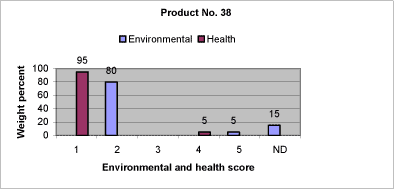
Fig. 8.7: Relative content of components in product no. 38 assigned the individual environmental and health scores. As can be seen in fig. 8.7, 80 % of the components in product no. 38 is assigned environmental score 2 and 5 % are assigned environmental score 5. 95 % of the components in product no. 38 is assigned health score1 and 5 % is assigned health score 4. For 15 % of the entering components it is not possible to establish an environmental score due to insufficient data. Based on available data, the total product is assigned environmental score 4 and health score 4. 8.3.8 Product no. 39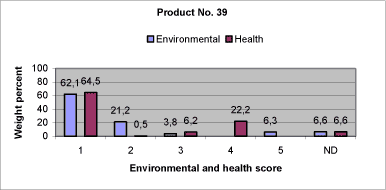
Fig. 8.8: Relative content of components in product no. 39 assigned the individual environmental and health scores. The individual environmental and health scores for product no. 39 are illustrated in fig. 8.8. As regards environmental hazard, 62.1 % of the components in product no. 39 is assigned score 1, 21.2 % is assigned score 2, 3.8 % is assigned score 3 and 6.3 % is assigned score 5. Regarding health hazard 64.5 % of the components in product no. 39 is assigned score 1, 0.5 % is assigned score 2, 6.2 % is assigned score 3 and 22.2 % is assigned score 4. For 6.6 % of the components in product no. 39 it is not possible to establish an environmental and health score due to insufficient data. Based on available data, the total product is assigned environmental score 4 and health score 4. 8.3.9 Product no. 40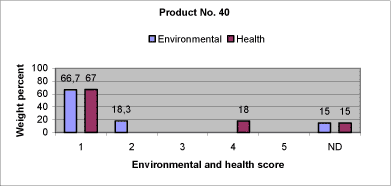
Fig. 8.9: Relative content of components in product no. 40 assigned the individual environmental and health scores. As can be seen in fig. 8.9, 66.7 % of the components contained in product no. 40 is assigned environmental score 1 and 18.3 % is assigned environmental score 2. 67.0 % of the components in product no. 40 is assigned health score 1 and 18.0 % is assigned health score 4. For 15 % of the entering components it is not possible to establish an environmental and health score due to insufficient data. Based on available data, the total product is assigned environmental score 1 and health score 4. 8.3.10 Product no. 41
Fig. 8.10: Relative content of components in product no. 41 assigned the individual environmental and health scores. As can be seen in fig. 8.10, 81.0 % of the components in product no. 41 is assigned environmental score 1, 1.5 % is assigned score 3 and 15.5 % is assigned environmental score 4. 96.5 % of the components in product no. 41 is assigned health score 1, 2.0 % is assigned score 3 and 1.5 % is assigned health score 4. For 2 % of the entering components it is not possible to establish an environmental score due to insufficient data. Based on available data, the total product is assigned environmental score 3 and health score 1. 8.3.11 Product no. 42
Fig 8.11: Relative content of components in product no. 42 assigned the individual environmental and health scores. As can be seen in fig. 8.11, 54.5 % of the components entering into product no. 42 is assigned environmental score 1, 17.5 % is assigned environmental score 3 and 28 % is assigned environmental score 4. All components in product no. 42 are assigned health score 1. The total product is assigned environmental score 4 and health score 1. 8.3.12 Product no. 45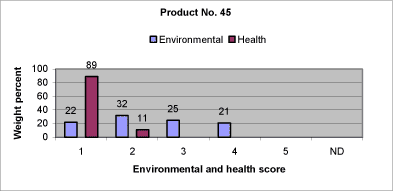
Fig. 8.12: Relative content of components in product no. 45 assigned the individual environmental and health scores. The individual environmental and health scores for product no. 45 are illustrated in fig. 8.12. As regards environmental hazard, 22.0 % of the components in product no. 45 is assigned score 1, 32.0 % is assigned score 2, 25.0 % is assigned score 3 and 21.0 % is assigned score 4. Regarding health hazard 89.0 % of the components in product no. 45 is assigned score 1 and 11.0 % is assigned score 2. The total product is assigned environmental score 3 and health score 1. 8.3.13 Product no. 51
Fig 8.13: Relative content of components in product no. 51 assigned the individual environmental and health scores. The individual environmental and health scores for product no. 51 are illustrated in fig. 8.13. As regards environmental hazard, 33.0 % of the components in product no. 51 is assigned score 1, 32.0 % is assigned score 2, 15.0 % is assigned score 3, 19.0 % is assigned score 4 and 1 % are assigned score 5. All components in product no. 51 are assigned health score 1. The total product is assigned environmental score 4 and health score 1. 8.3.14 Product no. 53
Fig 8.14: Relative content of components in product no. 53 assigned the individual environmental and health scores. The individual environmental and health scores for product no. 53 are illustrated in fig. 8.14. All components in product no. 21 are assigned environmental score 1 and health score 1 respectively. The total product is assigned environmental score 1 and health score 1. 8.3.15 Chlorinated lubricant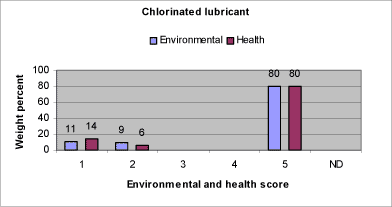
Fig. 8.15: Relative content of components in the reference product, a chlorinated lubricant, assigned the individual environmental and health scores. As can be seen from figure 8.15, 80 % of components in the reference product, a chlorinated lubricant, is assigned environmental and health score 5. This is due to the content of a medium-chain chlorinated paraffin. Medium-chain chlorinated paraffins (CAS-No. 85535-85-9) are proposed a classification as reprotoxic in category 3 with risk phrases R63: “Possible risk of harm to the unborn child“, R64: “May cause harm to breastfed babies”, R66: “Repeated exposure may cause skin dryness or cracking” and dangerous to the environment with risk phrase R50/53: “Very toxic to aquatic organisms, may cause long-term adverse effects in the aquatic environment”. This classification is proposed in the EU Risk Assessment on medium-chained chlorinated paraffins (CAS-No. 85535-85-9) human health draft February 2002 (3) and environment draft August 2000 (1). 11.0 % of the entering components are assigned environmental score 1 and 9 % is assigned environmental score 2. 14.0 % of entering components are assigned health score 1 and 6 % is assigned health score 2. The total product is assigned environmental score 5 and health score 5. 8.4 ConclusionsThe total product environmental scores of the proposed alternative lubricants are illustrated in fig. 8.16. The reference product – a chlorinated lubricant – is marked with an asterisk. 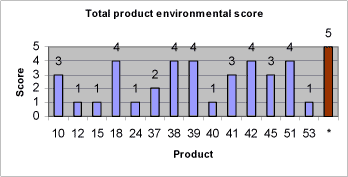
Figure 8.16 Total product environmental scores for proposed non-chlorinated lubricants in addition to the product environmental score for the reference lubricant – a chlorinated lubricant - marked with an asterisk ( * ). Based on the available data, the results of the environmental screening of the suggested alternative lubricants show that five non-chlorinated lubricants are assigned a total product environmental score 1, one lubricant is assigned a total product score 2 and eight non-chlorinated lubricants are assigned a total product environmental score 3 or 4. The total product health scores of the suggested alternative lubricants are illustrated in fig. 8.17. The reference product – a chlorinated lubricant – is marked with an asterisk. 
Figure 8.17 Total product health scores for proposed non-chlorinated lubricants in addition to the product health score for the reference lubricant – a chlorinated lubricant - marked with an asterisk ( * ). Eleven non-chlorinated lubricants are assigned a total product health score 1 while three non-chlorinated lubricants are assigned a total product health score 4. The reference product, a chlorinated lubricant, is assigned a total product health score 5. It can be concluded, that with reference to the health and environmental criteria established in section 3.3.1 and 3.3.2, apparently the majority of the non-chlorinated lubricants have acceptable health qualities based on available data while a substantial number of the same lubricants have environmental properties which should be avoided based on available data. Three of the proposed alternative lubricants are assigned a total product health score of 4 due to a content of component classified as sensitizing by skin contact. In the two cases, this classification is due to an organic amine and in the third case due to a polysulphide. Eight out of fourteen of the non-chlorinated lubricants are assigned a total product environmental score of 3 or 4. These environmental scores are due to a content of polysulphides, phosphorous compounds and/or calcium sulphonates. The health and environmental properties of all three substance groups are discussed further in chapter 7. The products considered as the best alternatives in a total health and environmental context based on criteria established in sections 3.3.1 and 3.3.2 are stated in table 8.1.
Table 8.1 The proposed lubricant alternatives considered as the health and environmentally best alternatives. For about half of the proposed non-chlorinated lubricants, there are no or insufficient data available for a number of entering components. This implies that there is no or insufficient data regarding potential health effects including data on acute oral toxicity, skin and eye irritation and sensitizing potential by skin contact. Regarding potential effects in the environment, this implies, that there is no or insufficient data available on aquatic toxicity and biodegradeability. Thus, assignment of a health and environmental score only implies that there is a minimum data set available concerning health and environmental effects. For a substantial part of the components in non-chlorinated lubricants there exists very limited data on health and environmental properties compared to chlorinated paraffins. See also chapter 7 on health and environmental assessment of components in non-chlorinated lubricants. It can be concluded that based on the sparse available data, non-chlorinated lubricants seem to possess improved inherent health and environmental properties compared to chlorinated lubricants. However, it should be kept in mind, that a number of the proposed non-chlorinated lubricants contain substances which are assigned environmental score 3 or 4 or even 5, though in lower concentrations than the typical concentration of chlorinated paraffins in the chlorinated lubricants. Further, substitution of chlorinated lubricants to the currently available non-chlorinated lubricant technologies implies a movement from a reasonable health and environmental data platform to a substantially poorer data platform.
|